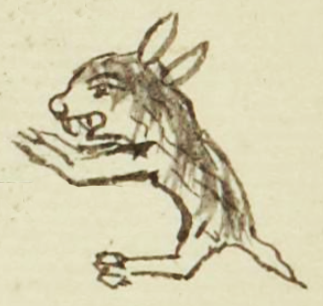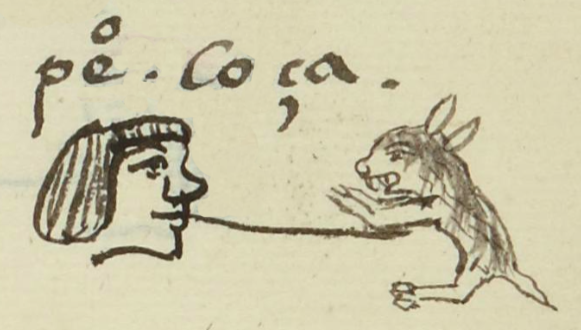Coza (MH660v)
This black-line drawing of the simplex glyph for the personal name Coza (perhaps "Weasel") shows a small animal in profile, facing toward the viewer’s left. Its front legs are raised as though it is in movement. Its teeth are bared. It has hatching on its back.
Stephanie Wood
Given the propensity for the letter “n” to drop or be intrusive, it is difficult to say for certain whether this person’s name is Coza or Cozan. Furthermore, the dictionaries are vague as to how to translate either word. The animal associated with the glyph for Cozamaloapan (Codex Mendoza, f. 46 recto) has a black mask across his eyes, probably a weasel. Images of weasels and ferrets show that both of these small animals can have a dark marking across the eyes and over the nose, but the same is not true for lynxes or snow leopards. Ferrets have died out in Mexico today, but weasels are still found there.
Stephanie Wood
peo. coça.
Pedro Coza
Stephanie Wood
1560
Jeff Haskett-Wood
linces, onzas, comadrejas, hurones, animales, nombres de hombres

coza(tli), weasel or ferret, https://nahuatl.wired-humanities.org/content/cozatli
cozan(tli), lynx or snow leopard, https://nahuatl.wired-humanities.org/content/cozantli
Comadreja, u Hurón
Stephanie Wood
Matrícula de Huexotzinco, folio 660v, World Digital Library, https://www.loc.gov/resource/gdcwdl.wdl_15282/?sp=401&st=image
This manuscript is hosted by the Library of Congress and the World Digital Library; used here with the Creative Commons, “Attribution-NonCommercial-ShareAlike 3.0 License” (CC-BY-NC-SAq 3.0).



